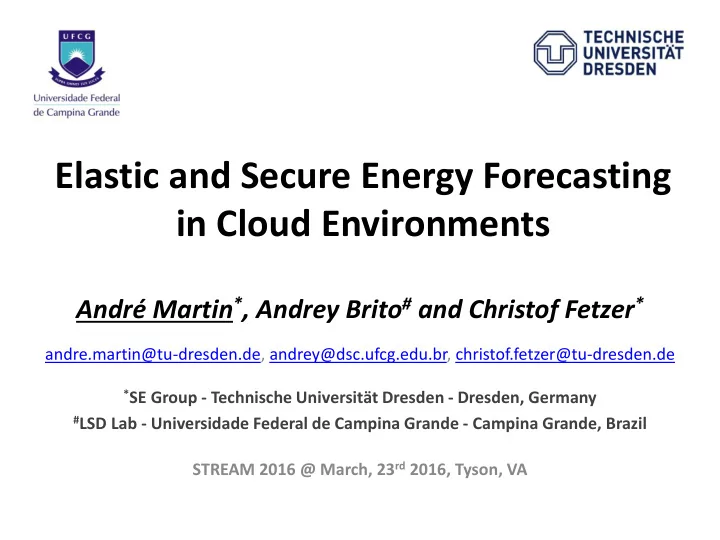

Elastic and Secure Energy Forecasting in Cloud Environments André Martin * , Andrey Brito # and Christof Fetzer * andre.martin@tu-dresden.de, andrey@dsc.ufcg.edu.br, christof.fetzer@tu-dresden.de * SE Group - Technische Universität Dresden - Dresden, Germany # LSD Lab - Universidade Federal de Campina Grande - Campina Grande, Brazil STREAM 2016 @ March, 23 rd 2016, Tyson, VA
Application Example SmartGrid ACM DEBS’14 Challenge: SmartMeter recordings Query #1: Provide load predication (two times slices ahead) based on complete set of historical collected measurements Query #2: Detect outliers based on (global) median value of a 24hrs sliding time window 2
Challenges when Processing of SmartMeter data 1. Data growth Q1: Accumulating historic data (to improve forecasts) Q2: Temporary large states due to (24hr) sliding window Solution: Elastic stream processing & cloud computing 2. Privacy concerns cloud computing Processing of privacy sensitive data (SmartPlugs) 3
State of The Art Open Source Technologies Elasticity & Privacy State support Seep Feature Imperial College State support/pers Yes User KV store Exactly Once Sematic User Transactional proc. Yes Challenge #1: Elasticity Scale Out (expand) Yes Partially (no migr) (Yes) * Scale In (contract) No No (killing proc.) (Yes) * *at least once Challenge #2: Privacy Preservation Channel No Partially (netty.io) No Processing No No No 4
Our Approach to Elasticity • Stateful stream processing using StreamMine3G Operator migration protocol [1] provides: Exactly once processing semantics is based on active replication [1] Elastic Scaling of a High-Throughput Content-Based Publish/Subscribe Engine (Raphaël Barazzutti, Thomas Heinze, André Martin, Emanuel Onica, Pascal Felber, Christof Fetzer, Zbigniew Jerzak, Marcelo Pasin, Etienne Rivière), In ICDCS '14: 34th IEEE International Conference on Distributed Computing Systems 5
Our Approach to Privacy Preserving Stream Processing Intel SGX ( S afe G uard E x tensions) • Trusted environment ( enclave ) for arbitrary code • Enclave memory cannot be accessed from non- enclave code • Enclave code has access to outside code/data • Remote attestation of enclave code • Available in all new Skylake processors since Q4/15 • User solely need to trust Intel 6
Intel SGX & Stream Processing Approach #1 • whole process runs in enclave Node Operator • secure channels (via TLS/SSL) Queue Queue Node Operator Queue Queue Node Operator Queue Queue 7
Intel SGX & Stream Processing Approach #2 • only operator runs in enclave Node Operator • incoming data decrypted in op. Queue Queue • outgoing data encrypted in op. Node Operator Queue Queue Node Operator Queue Queue 8
Approach #2 Transparent Wrapper Node Operator Queue Queue original operator code message/tuple encoder/decoder enclave interception message passing 9
Intel SGX Research Challenges 1. Limited EPC ( E nclave P age C ache ) size (128MB) → How to deal with large operator state? “Swapping”: Mechanisms provided by SGX vs. state eviction & encryption strategies tailored to ESP 2. System call interface protection libmusl – exchange data in a controlled manner 3. Enclave threads vs. user space threads How to pass data efficiently between the two worlds? 10
Summary & Conclusions 1. Lack of elasticity support in open source technologies for highly dynamic applications Explicit state support Migration protocol 2. Lack of privacy preserving stream processing Operators run in enclaves (Intel SGX) Transparent/non-invasive approach Promising direction – roll out of Skylake processors in Q4/15 Thank you for your attention – Q&A andre.martin@se.inf.tu-dresden.de 11
Recommend
More recommend